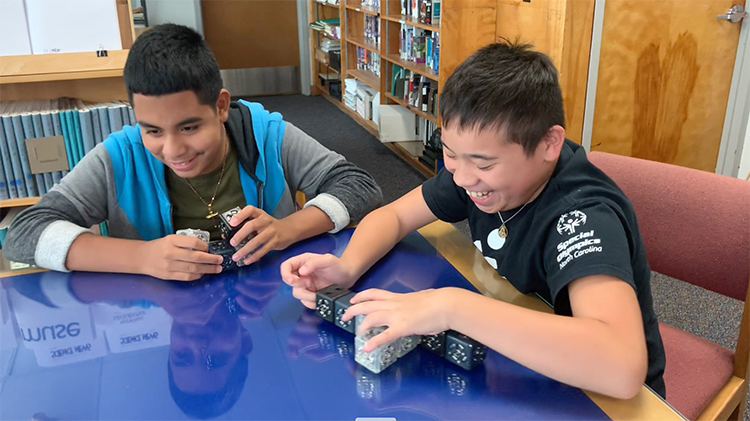 Cubelets are utilized at GMS in a variety of ways, most notably in the library. The robot blocks serve as vehicles for students to think outside the box and explore their creativity. Students use their tactile and sensory skills to create robots that spin, roll, and produce light. They also control the movements of their robots using Bluetooth technology.
“Each week, we introduce a new Cubelet robot that does something different,” says Ms. Powell, “For example, we may introduce a noise projecting Cubelet. We teach our students how to explore and connect the Cubelet to utilize its proper function.”
Continue reading
Cubelets are utilized at GMS in a variety of ways, most notably in the library. The robot blocks serve as vehicles for students to think outside the box and explore their creativity. Students use their tactile and sensory skills to create robots that spin, roll, and produce light. They also control the movements of their robots using Bluetooth technology.
“Each week, we introduce a new Cubelet robot that does something different,” says Ms. Powell, “For example, we may introduce a noise projecting Cubelet. We teach our students how to explore and connect the Cubelet to utilize its proper function.”
Continue reading
The goal at Governor Morehead School in Raleigh, North Carolina is to have all students “strive for the highest levels of educational excellence and integrity in all of life’s endeavors.” As a residential school for students who are blind or have limited vision, this goal presents unique challenges to their staff. That’s why Caitlin Powell, a Residential Life Trainer at Governor Morehead School (GMS), and Janet Perez, the Instructional Technology Specialist, were so excited to find a STEAM resource like Cubelets.
“Cubelets allow our students to explore, experiment, and engage in hands-on creative problem-solving, right out of the box,” Ms. Perez says. “I haven’t even had to add tactile indicators because most of the blocks can be identified by touch.”
 Cubelets are utilized at GMS in a variety of ways, most notably in the library. The robot blocks serve as vehicles for students to think outside the box and explore their creativity. Students use their tactile and sensory skills to create robots that spin, roll, and produce light. They also control the movements of their robots using Bluetooth technology.
“Each week, we introduce a new Cubelet robot that does something different,” says Ms. Powell, “For example, we may introduce a noise projecting Cubelet. We teach our students how to explore and connect the Cubelet to utilize its proper function.”
Continue reading
Cubelets are utilized at GMS in a variety of ways, most notably in the library. The robot blocks serve as vehicles for students to think outside the box and explore their creativity. Students use their tactile and sensory skills to create robots that spin, roll, and produce light. They also control the movements of their robots using Bluetooth technology.
“Each week, we introduce a new Cubelet robot that does something different,” says Ms. Powell, “For example, we may introduce a noise projecting Cubelet. We teach our students how to explore and connect the Cubelet to utilize its proper function.”
Continue reading
 Cubelets are utilized at GMS in a variety of ways, most notably in the library. The robot blocks serve as vehicles for students to think outside the box and explore their creativity. Students use their tactile and sensory skills to create robots that spin, roll, and produce light. They also control the movements of their robots using Bluetooth technology.
“Each week, we introduce a new Cubelet robot that does something different,” says Ms. Powell, “For example, we may introduce a noise projecting Cubelet. We teach our students how to explore and connect the Cubelet to utilize its proper function.”
Continue reading
Cubelets are utilized at GMS in a variety of ways, most notably in the library. The robot blocks serve as vehicles for students to think outside the box and explore their creativity. Students use their tactile and sensory skills to create robots that spin, roll, and produce light. They also control the movements of their robots using Bluetooth technology.
“Each week, we introduce a new Cubelet robot that does something different,” says Ms. Powell, “For example, we may introduce a noise projecting Cubelet. We teach our students how to explore and connect the Cubelet to utilize its proper function.”
Continue reading 
 “Once [the students] got to know the Cubelets, they became very excited. You could easily observe their enjoyment and comfort level increase.” Mr. Adame and Ms. Garza go on to say that when the students use Cubelets, “you see smiling faces accompanied with giggles and laughter.”
“Once [the students] got to know the Cubelets, they became very excited. You could easily observe their enjoyment and comfort level increase.” Mr. Adame and Ms. Garza go on to say that when the students use Cubelets, “you see smiling faces accompanied with giggles and laughter.”
 It took some time, however to realize his makerspace vision.
It took some time, however to realize his makerspace vision.

